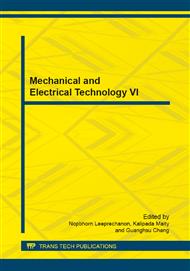[1]
F. Javier L´opez-Mart´ınez, E. Martos-Naya, Jos´e F. Paris, Unai Fern´andez-Plazaola, Higher Order Statistics of Sampled Fading Channels with Applications, IEEE (2012).
DOI: 10.1109/tvt.2012.2199528
Google Scholar
[2]
Nasiba Mandal, Analysis of Higher Order Statistics in various Discrete Fading Channels, Master of Engineering Thesis, Shri G. S. Institute of Technology and Science, Indore, (2013).
Google Scholar
[3]
A. Abdi, K. Wills, H. Allen Barger, Mohamed-Slim Alouini, and Mostafa Kaveh, Comparison of the Level Crossing Rate and Average Fade Duration of Rayleigh, Rice, and Nakagami Fading Models with Mobile Channel Data, IEEE Vehicular Trans., (2000).
DOI: 10.1109/vetecf.2000.886139
Google Scholar
[4]
T. S. Rappaport, Wireless Communications-Principles and Practice, Prentice Hall, (2000).
Google Scholar
[5]
W Jakes, Microwave mobile communications, IEEE Press classic reissue, Wiley, (1974).
Google Scholar
[6]
G. L. Stuber, Principles of mobile communication, Norwell MA, Kluwer, (2001).
Google Scholar
[7]
M. D. Yacoub, J. E. V. Bautista and L. G. Rezende Guedes, On higher order statistics of the Nakagami-m distribution, IEEE Trans. on Vehicular Technology, 48, May (1999).
DOI: 10.1109/25.764995
Google Scholar
[8]
N. Youssef, C. X. Wang, and M. Patzold, A Study on the Second Order Statistics of Nakagami-Hoyt Mobile Fading Channels, IEEE Trans. on Vehicular Technology, 54, (2005).
DOI: 10.1109/tvt.2005.851353
Google Scholar
[9]
N. C. Sagias, D. A. Zogas, G. K. Karagiannidis, and G. S. Tombras, Channel capacity and second-order statistics in Weibull fading, IEEE Comm. Letters, Vol. 8, 377–379, June (2004).
DOI: 10.1109/lcomm.2004.831319
Google Scholar
[10]
D. B. da Costa, J. C. Silveira Santos Filho, M. D. Yacoub, and G. Fraidenraich, Second-Order Statistics of eta-mu Fading Channels: Theory and Applications, IEEE Trans. on Wireless Communications, Vol. 7, p.819–824, March (2008).
DOI: 10.1109/twc.2008.060774
Google Scholar
[11]
S. L. Cotton and W. G. Scanlon, Higher-order statistics for k-distribution, Electronics Letters, Vol. 43, (2007).
Google Scholar
[12]
D. B. da Costa, J. C. S. Santos Filho, M. D. Yacoub, and G. Fraidenraich, Crossing rates and fade durations for diversity-combining schemes over fading channels, IEEE Trans. on Wireless Communications, Vol. 6, p.4263–4267, December (2007).
DOI: 10.1109/twc.2007.060387
Google Scholar
[13]
C. D. Iskander and P. Takis Mathiopoulos, Analytical level crossing rates and average fade durations for diversity techniques in Nakagami fading channels, IEEE Trans. on Communications, Vol. 50, p.1301–1309, August (2002).
DOI: 10.1109/tcomm.2002.801465
Google Scholar
[14]
N. C. Beaulieu and X. Dong, Level crossing rate and average fade duration of MRC and EGC diversity in Ricean fading, IEEE Trans. on Communications, Vol. 51, p.722–726, May (2003).
DOI: 10.1109/tcomm.2003.811380
Google Scholar


